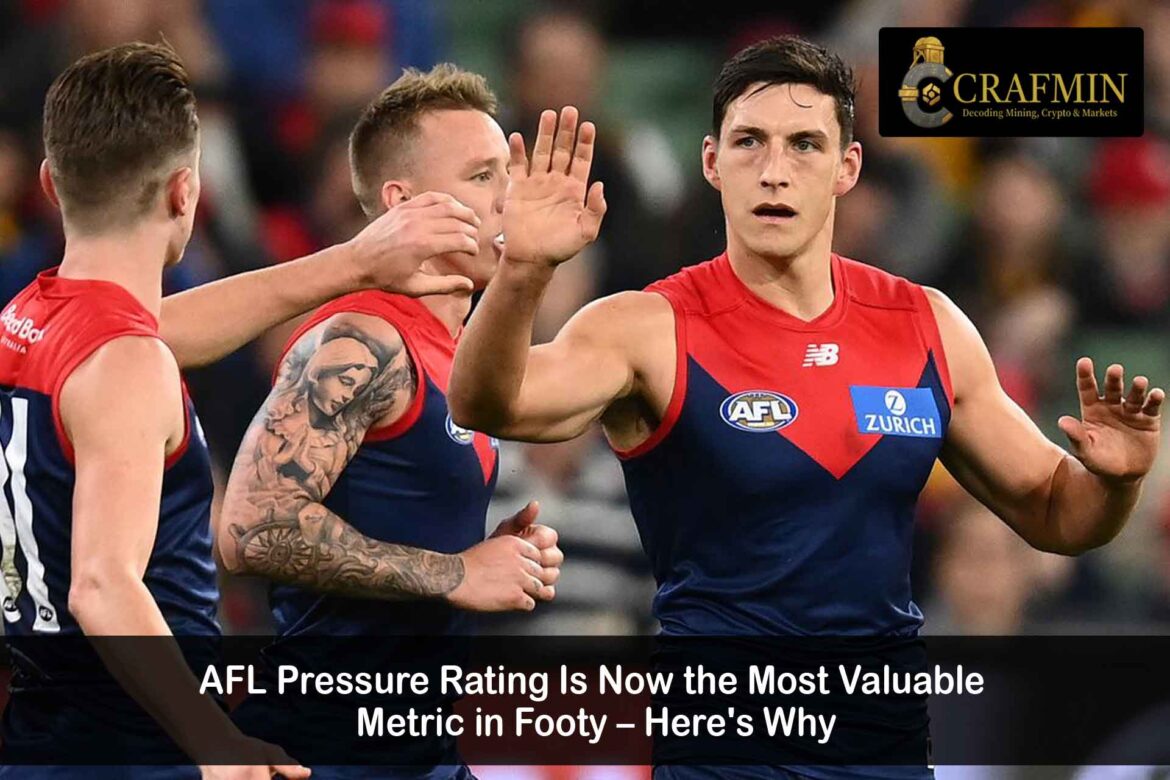
Credit: Fox Sports
In a game built on speed, collisions, and chaos, quantifying “effort” in Australian Rules Football has always been a challenge. But in 2025, one metric is emerging as the definitive measure of team intent: the AFL pressure rating. What once lived only in coach’s meetings and back-room analysis is now front and centre — broadcast on Fox Sports AFL 360, dissected by commentators, and quoted by head coaches during post-match pressers.
With the rise of Champion Data’s pressure metrics, AFL fans, analysts, and teams alike are learning to see the game through a new lens — one where effort is measurable, trends are predictable, and strategy is increasingly data-driven.
Also Read: WA Government Allocates A$1.4 Billion to Mining Diversification in 2025–26 Budget
What Is the AFL Pressure Rating?
The pressure rating is a composite metric developed by Champion Data to quantify the intensity a team applies on the opposition — both on and off the ball. It includes physical acts like:
- Tackles
- Corralling
- Spoils
- Smothers
- Applying pressure acts within 3 metres of the ball carrier
The pressure rating fluctuates in real time and is measured on a scale where:
- Below 160 = passive quarter
- 180–190 = competitive
- Above 200 = elite pressure
By round 10 of the 2025 season, six teams have already recorded a quarter above 205, a rare feat two years ago. This has prompted fans to question: is footy faster and fiercer than ever — or just finally measurable?
Pressure Rating Table – Rounds 1–10, 2025
| Team | Avg Pressure Rating | League Rank |
| Collingwood | 198 | 1st |
| Sydney | 191 | 2nd |
| Carlton | 189 | 3rd |
| Melbourne | 186 | 4th |
| Richmond | 185 | 5th |
| Fremantle | 177 | 10th |
Collingwood’s intensity under pressure has become their hallmark — particularly in second halves, where they regularly cross the 195 mark after halftime. Fox Sports AFL 360 highlighted this with animated graphics in their Round 6 segment, calling the Magpies’ style “controlled chaos at peak pressure.”
Why Coaches Are Obsessed
Adam Simpson (West Coast) and John Longmire (Sydney) have both publicly referenced pressure rating this year. That alone speaks volumes. Coaches are now using it to:
- Set benchmarks for different quarters
- Decide when to rotate midfielders
- Trigger zone traps or congestion tactics
For example, Sydney’s midfield is trained to spike pressure at the 12-minute mark of each quarter — exploiting fatigue in opposition half-backs. They averaged 12 forward-half turnovers per quarter during Rounds 5–9.
Even player selection is starting to shift. Players who rank top 10 in pressure acts per minute — even if they don’t rack up possessions — are now considered valuable system players.
Media Coverage: From Stat to Storyline
The Fox Sports AFL 360 panel has leaned into pressure rating as a storytelling tool. In post-game breakdowns, they overlay pressure heat maps with goal timelines — helping fans understand momentum swings.
One segment titled “The Pressure Flip” showed how Richmond lifted their rating from 165 to 197 in the third quarter against Brisbane, flipping a 3-goal deficit into a 2-goal lead. It wasn’t just effort — it was execution under stress.
Meanwhile, Champion Data has introduced live graphs into their media feeds, letting broadcasters show minute-by-minute pressure waves. This mirrors the kind of data you’d see in elite soccer or NBA analytics — except AFL, with its 360-degree chaos, might be the sport that needs it most.
The Next Evolution: Pressure Efficiency
Sources within Champion Data suggest the next frontier will be “Pressure Efficiency Index” (PEI) — a metric combining pressure acts with outcomes:
- Forced turnovers
- Rushed kicks
- Intercepts after pressure
This could tell teams not just who applies the most pressure — but who does it effectively. For recruiters and high-performance analysts, this would be game-changing.
Don’t be surprised if future contracts include pressure clauses the same way intercepts and disposals are tracked now.
Why This Matters More Than Ever
In a sport where small margins decide finals, quantifiable intensity is gold. Pressure rating isn’t just another number — it’s becoming the heartbeat of team DNA. Clubs with high pressure profiles like Collingwood, Sydney, and Melbourne are consistently out-tackling, out-chasing, and outlasting opponents.
Meanwhile, fans now understand effort beyond “he looks switched on.” They’re seeing the game through metrics that reward sacrifice and system — not just stats on a scoreboard.
Conclusion: Footy’s Toughest Metric Is Here to Stay
The AFL pressure rating has emerged as the most telling indicator of team mindset. Whether it’s built into coaching triggers, broadcast graphics, or player valuation, it’s changing the fabric of how footy is played and understood.
As analytics deepen and Champion Data refines its tools, pressure will remain more than just a stat — it will be a symbol of accountability, identity, and premiership potential.

